
- News
- Columns
- Interviews
- Law Firms
- Apprentice Lawyer
- Legal Jobs
- हिंदी
- ಕನ್ನಡ

The hearing in the Sabarimala case in Supreme Court is now slated to spill over into the seventh day. The six days of hearing has witnessed very healthy interactions between the judges on the Bench and the lawyers. Justice DY Chandrachud and Justice Rohinton Nariman have been particularly active with both the judges frequently raising questions.
While the mood of the Bench which was largely discernible during the first five days, the second half of the hearing today witnessed a young lawyer Sai Deepak J who argued for intervenors against the petition, giving the judges on the Bench some food for thought.
Aside from that, what stood out in today’s hearing was Justice Chandrachud’s take on a controversial piece of jurisprudence which has originated from and evolved by the Supreme Court – the Essential Religious Practices Test also known as Essentiality test.
The doctrine of essentiality originated in 1954 judgment of Supreme Court in The Commissioner, Hindu Religious Endowments, Madras v. Shri Lakshmindar Thirtha Swamiyar of Shri Shirur Mutt popularly known as Shirur Matt case.
The court, in that case, chose a very safe route stating that what constitutes the essential part of a religion is to be ascertained with reference to the doctrines of that religion itself.
“…what constitutes the essential part of a religion is primarily to be ascertained with reference to the doctrines of that religion itself. If the tenets of any religious sect of the Hindus prescribe that offerings of food should be given to the idol at particular hours of the day, that periodical ceremonies should be performed in a certain way at certain periods of the year or that there should be daily recital of sacred texts or ablations to the sacred fire, all these would be regarded as parts of religion and the mere fact that they involve expenditure of money or employment of priests and servants or the use of marketable commodities would not make them secular activities partaking of a commercial or economic character; all of them are religious practices and should be regarded as matters of religion within the meaning of article 26(b).”
The Court even went to the extent of stating that a religious denomination or organization enjoys complete autonomy in deciding as to what rites and ceremonies are essential according to the tenets of the religion they hold and no outside authority has any jurisdiction to interfere with their decision in such matters.
However, in the subsequent years, the use of the doctrine by the court to decide what is “essential” to religion and what is not led to many contradictory stances by the same court.
As pointed out by advocate Aankhi Ghosh, the doctrine is judge-centric and such an approach to justice sans an iota of consistency is positively bothering, even if it demonstrates itself mostly in the form of interim orders.
“Does it suit a constitutional court to use such a half-baked, whimsical doctrine as the basis for deciding precious fundamental rights issues of a billion-odd people?”, Aankhi had asked in her article.
And today Justice Chandrachud echoed this thought!
Calling it a problem with our jurisprudence he said, that Article 25 has been taken over by this doctrine and how that could be a problem for Constitutional courts.
“There is a problem with our jurisprudence. Essentiality aspect has taken charge of A.25 but it should not be so. Because if something is essential it becomes inviolable.”
Justice Chandrachud’s take was that if a practice is essential to a religion, then it rules out testing that practice on benchmarks of the Constitution or Constitutional morality. Thus, it could help perpetuate an immoral or outdated or unconstitutional practice in the name of religious freedom.
However, the interesting point is that it is the judges themselves who have been deciding what constitutes an essential practice and what does not, on a case to case basis. Justice Chandrachud also recognised this completely when he stated,
“Due to this essentiality doctrine, Judges including Supreme Court judges are now assuming a theological mantle which we are not expected to do.”
And what is his solution? Constitutional morality irrespective of whether a practice is essential or not.
“The test should be whether a practice subscribes to the Constitution irrespective of whether it is essential or not”.
This could be a significant step in that it could have a major impact on various practices and customs of all religions including on personal laws.
While people from all sides of the political and religious spectrum have argued against Essential Religious Practices Test, it remains to be seen how many of them would support Justice Chandrahcud’s alternative to the same.
A State without religion becoming a State bereft of religions might not suit vote bank politics.
Question of Law will be a column regularly analysing interesting snippets from courts.
Murali Krishnan is Associate Editor at Bar & Bench. He tweets @legaljournalist.